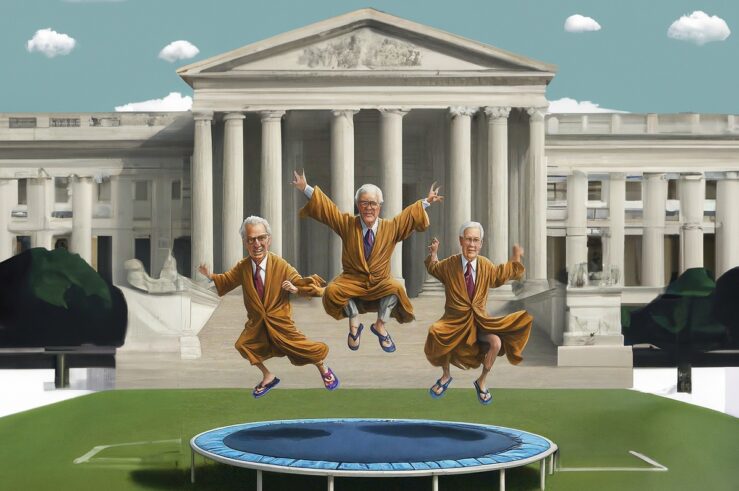Interested observers on all sides of the contentious debate over Aereo have focused a great deal on the implications for cloud computing if the Supreme Court rules against Aereo. The Court hears oral argument next week, and the cloud computing issue is sure to make an appearance.
Several parties that filed amicus briefs in the case weighed in on the issue. The Center for Democracy & Technology, for example, filed abrief arguing that a ruling against Aereo would hinder the development of cloud computing. Thirty-six Intellectual Property and Copyright Law Professors also filed a brief arguing this point. On the other hand, the United States—represented by the Solicitor General—devoted a section of its amicus brief in support of copyright owners’ argument that the Court could rule against Aereo without undermining cloud computing.
Our organizations, the International Center for Law and Economics and the Competitive Enterprise Institute, filed an amicus brief in the case in support of the Petitioners (as did many other policy groups, academics, and trade associations). In our brief we applied the consumer welfare framework to the question whether allowing Aereo’s business practice would increase the societal benefits that copyright law seeks to advance. We argued that holding Aereo liable for copyright infringement was well within the letter and spirit of the Copyright Act of 1976. In particular, we argued that Aereo’s model is less a disruptive innovation than a technical work-around taking advantage of the Second Circuit’s overbroad reading of the law in the Cablevision case.
Although our brief didn’t directly address cloud computing writ large, we did articulate a crucial distinction between Aereo and other cloud computing providers. Under our reasoning, the Court could rule against Aereo—as it should—without destroying cloud computing—as it should not.
Background
By way of background, at the center of the legal debate is what it means to “perform [a] copyrighted work publicly.” Aereo argues that because only one individual subscriber is “capable of receiving” each transmission its service delivers, its performances are private, not public. The Copyright Act gives copyright owners the exclusive right to publicly perform their works, but not the right to perform them privately. Therefore, Aereo contends, its service doesn’t infringe upon copyright owners’ exclusive rights.
We disagree. As our brief explains, Aereo’s argument ignores Congress’ decision in the Copyright Act of 1976 to expressly define the transmission of a television broadcast “by means of any device or process” to the public as a public performance, “whether the members of the public capable of receiving the performance … receive it in the same place or in separate places and at the same time or at different times.” Aereo has built an elaborate system for distributing live high-def broadcast television content to subscribers for a monthly fee—without obtaining permission from, or paying royalties to, the copyright owners in the audiovisual works aired by broadcasters.
Although the Copyright Act’s text is less than artful, Congress plainly wrote it so as to encompass businesses that sell consumers access to live television broadcasts, whether using traditional means—such as coaxial cable lines—or some high-tech system that lawmakers couldn’t foresee in 1976.
What does this case mean for cloud computing? To answer this question, it’s worth dividing the discussion into two parts: one addressing cloud providers that don’t sell their users licenses to copyrighted works, and the other addressing cloud providers that do. Dropbox and Mozy fit in the first category; Amazon and iTunes fit in the second.
A Ruling Against Aereo Won’t Destroy Cloud Computing Services like Dropbox
According to the 36 Intellectual Property and Copyright Law Professors, a loss for Aereo would be bad news for cloud storage providers such as Dropbox:
If any service making multiple transmissions of the same underlying copyrighted audiovisual work is publicly performing that work, then the distinction between video-on-demand services and online storage services would vanish, and all such services would henceforth face infringement liability. Thus, if two Dropbox users independently streamed “We, the Juries,” then under Petitioners’ theory, those two transmissions would be aggregated together, making them collectively “to the public.” Under Petitioners’ theory of this case—direct infringement by public performance—that would be game, set, and match against Dropbox.
This sounds like bad news for the cloud. Fortunately, however, Dropbox has little to fear from an Aereo defeat, even if the professors are right to worry about an overbroad public performance right (more on this below). The Digital Millenium Copyright Act (DMCA) grants online service providers—including cloud hosting services such as Dropbox—a safe harbor from copyright infringement liability for unwittingly storing infringing files uploaded by their users. In exchange for this immunity, service providers must comply with the DMCA’snotice and takedown system and adopt a policy to terminate repeat-infringing users, among other duties.
Although 17 U.S.C. § 512(c) refers only to infringement “by reason of … storage” directed by a user, courts have consistently interpreted this language to “encompass[] the access-facilitating processes that automatically occur when a user uploads” a file to a cloud hosting service. Whether YouTube streams an infringing video once or 1,000,000 times, therefore, it retains its DMCA immunity so long as it complies with the safe harbor’s requirements. So even if Aereo loses, and every DropBox user who streams “We, the Juries” is receiving a public performance, DropBox will still be safe from copyright infringement liability in the same way as YouTube, Vimeo, DailyMotion, and countless other services are safe today.
An Aereo Defeat Won’t Kill Cloud Computing Services like Amazon and Google
As for cloud computing providers that provide copyrighted content, the legal analysis is admittedly trickier. These providers, such as Google and Amazon, contract with copyright holders to sell their users licenses to copyrighted works. Some providers offer a subscription to streaming content, for which the provider has typically secured public performance licenses from the copyright owners. Cloud providers also sell digital copies of copyrighted works—that is, non-transferable lifetime licenses—for which the provider has generally obtained reproduction and distribution licenses, but not public performance rights.
But, as copyright law guru Devlin Hartline argues, determining if a performance is public or private turns on whether the cloud provider’s “volitional conduct [is] sufficient such that it directly causes the transmission.” When a user streams her own licensed content from a cloud service, it remains a private performance because the cloud service took no willful steps to facilitate the playback of copyrighted material. (The same is true for Dropbox-like services, as well.) Aereo, conversely, “crosse[s] the line from being a passive conduit to being an active participant because it supplies the very content that is available using its service.”
Neither Google’s nor Amazon’s business models much resemble Aereo’s, which entails transmitting content for which the company has secured no copyright licenses—either for itself or for its users. And to the extent that these services do supply the content being transmitted (as Spotify or Google Play All Access do, for example), they secure the appropriate public performance right to do so. Indeed, critics who have focused on cloud computing fail to appreciate how the Copyright Act distinguishes between infringing technologies such as Aereo and lawful uses of the cloud to store, share, and transmit copyrighted works.
For instance, as CDT notes:
[S]everal companies (including Google and Amazon) have launched personal music locker services, allowing individuals to upload their personal music collections “to the cloud” and enabling them to transmit that music back to their own computers, phones, and tablets when, where, and how they find most convenient.
And other critics of broadcasters’ legal position have made similar arguments, claiming that the Court cannot reach a holding that simultaneously bars Aereo while allowing cloud storage:
[I]f Aereo is publicly performing when you store a unique copy of the nightly news online and watch it later, then why aren’t cloud services publicly performing if they host your (lawful) unique mp3 of the latest hit single and stream it to you later?… The problem with this rationale is that it applies with equal force to cloud storage like Dropbox, SkyDrive, iCloud, and Google Drive. If multiple people store their own, unique, lawfully acquired copy of the latest hit single in the cloud, and then play it to themselves over the Internet, that too sounds like the broadcasters’ version of a public performance. The anti-Aereo rationale doesn’t distinguish between Aereo and the cloud.
The Ability to Contract is Key
These arguments miss the important concept of privity. A copyright holder who does not wish to license the exclusive rights in her content cannot be forced to do so (unless the content is subject to a compulsory license). If a copyright holder prefers its users not upload their licensed videos to the cloud and later stream them for personal use, the owner can include such a prohibition in its licenses. This may affect users’ willingness to pay for such encumbered content—but this is private ordering in action, with copyright holders and licensees bargaining over control over copyrighted works, a core purpose of the Copyright Act.
When a copyright holder wishes to license content to a cloud provider or user, the parties can bargain over whether users may stream their content from the cloud. These deals can evolve over time in response to new technology and changing consumer demand. This happens all the time—as in therecent deal between Dish and Disney over the Hopper DVR, wherein Dish agreed that Hopper would automatically excise the commercials accompanying ABC content only after three days elapse after each show airs.
But Aereo forecloses the possibility of such negotiation, making all over-the-air content available online to subscribers absent any agreement with the underlying copyright owners of such programs. Aereo is thus distinct from other cloud services that supply content to their users, as the latter have permission to license their content.
Of course, broadcasters make their programming freely available over the airwaves, without any express agreement with viewers. But this doesn’t mean broadcasters lose their legal right to restrict how third parties distribute and monetize their content. While consumers can record and watch such broadcasts at their leisure, they can’t record programs and then sell the rights to the content, for example, simply replicating the broadcast. The fact that copyright holders have entered into licenses to “cloud-ify” content with dedicated over-the-top apps and Hulu clearly suggests that the over-the-air “license” is limited. And because Aereo refuses to deal with the broadcasters, there’s no possibility of a negotiated agreement between Aereo and the content owners, either. The unique combination of broadcast content and an unlicensed distributor differentiates the situation in Aereo from typical cloud computing.
If broadcasters can’t rely on copyright law to protect them from companies like Aereo that simply repackage over-the-air content, they may well shift all of their content to cable subscriptions instead of giving a free option to consumers. That’s bad news for folks who access free television—regardless of the efficiency of traditional broadcasting, or lack thereof.
The Cablevision Decision Doesn’t Require a Holding for Aereo
Commentators argue that overruling the Second Circuit in Aereo necessarily entails overruling the Second Circuit’s Cablevision holding—and with it that ruling’s fair use protections for DVRs and other cloud computing functionality. We disagree, however. Rather, regardless of whether Cablevision was correctly decided, its application to Aereo is improper.
In Cablevision, the individual cable subscribers to whom Cablevision transmitted copies of plaintiff Cartoon Network’s television programming were already paying for lawful access to it. Cartoon Network voluntarily agreed to license its copyrighted works to Cablevision and, in turn, to each Cablevision subscriber whose cable package included the Cartoon Network channel.
The dispute in Cablevision thus involved a copyright holder and a licensee with a preexisting contractual relationship; the parties simply disagreed on the terms by which Cablevision was permitted to transmit Cartoon Network’s content. But even after the decision, Cartoon Network remained (and remains) free to terminate or renegotiate its licensing agreement with Cablevision.
Again, this dynamic of voluntary exchange mitigates Cablevision’s impact on the market for television programming, as copyright holders and cable companies settle on a new equilibrium. But unlike the cable company in Cablevision, Aereo has neither sought nor received permission from any holders of copyrights in broadcast television programming before retransmitting their works to paying subscribers.
Even if it is correct that Aereo itself isn’t engaging in public performance of copyrighted work, it remains the case that its subscribers haven’t obtained the right to use Aereo’s services, either. But one party or the other must obtain this right or else establish that it’s a fair use.
Fair Use Won’t Save Aereo
The only way legitimately to rule in Aereo’s favor would be to decide that Aereo’s retransmission of broadcast content is a fair use. But as Cablevision’s own amicus brief in Aereo (supporting Aereo) argues, fair use rights don’t cover Aereo’s non-transformative retransmission of broadcast content. Cloud computing providers, on the other hand, offer services that enable distinct functionality independent of the mere retransmission of copyrighted content:
Aereo is functionally identical to a cable system. It captures over-the-air broadcast signals and retransmits them for subscribers to watch. Aereo thus is not meaningfully different from services that have long been required to pay royalties. That fact sharply distinguishes Aereo from cloud technologies like remote-storage services and remote DVRs.
* * *
Aereo is not in the business of transmitting recorded content from individual hard-drive copies to subscribers. Rather, it is in the business of retransmitting broadcast television to subscribers.
* * *
Aereo…is not relying on its separate hard-drive copies merely to justify the lawfulness of its pause, rewind, and record functions. It is relying on those copies to justify the entire television retransmission service. It is doing so even in the many cases where subscribers are not even using the pause, rewind, or record functions but are merely watching television live.
It may be that the DVR-like functions that Aereo provides are protected, but that doesn’t mean that it can retransmit copyrighted content without a license. If, like cable companies, it obtained such a license, it might be able to justify its other functionality (and negotiate license terms with broadcasters to reflect the value to each of such functionality). But that is a fundamentally different case. Similarly, if users were able to purchase licenses to broadcast content, Aereo’s additional functionality might also be protected (with the license terms between users and broadcasters reflecting the value to each). But, again, that is a fundamentally different case. Cloud computing services don’t create these problems, and thus need not be implicated by a proper reading of the Copyright Act and a ruling against Aereo.
Conclusion
One of the main purposes of copyright law is to secure for content creators the right to market their work. To allow services like Aereo undermines that ability and the incentives to create content in the first place. But, as we have shown, there is no reason to think a ruling against Aereo will destroy cloud computing.






